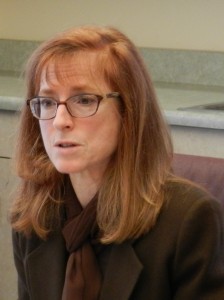
“Why not do a mass balance?” said Vance Kennedy. “It’s unsustainable on the face of it.”
Kennedy was speaking during a question and answer session with Doreen, “DeDe,” D’Adamo, a member of California’s State Water Resources Control Board. D’Adamo was in Oakdale last Wednesday to meet with members of the Stanislaus Water Coalition, a group concerned with groundwater issues in eastern Stanislaus County.
Kennedy, a retired U.S. Geological Survey hydrologist, has grown increasingly frustrated with what he sees as a looming environmental disaster on Stanislaus County’s east side, where almond growers continue to pump over a hundred thousand acre feet of groundwater a year to feed their thirsty orchards.
“That groundwater is hundreds of years old,” said Kennedy recently. “Some of it is thousands of years old. That could be the water that gets us through a drought like they’re having in Australia. Instead, it’s being frittered away.”
Among those present at Wednesday’s meeting in Oakdale, Kennedy’s was one of three points of view that have dominated local groundwater discussions since the ongoing drought has magnified alarm over disappearing groundwater supplies statewide. Kennedy believes a “mass balance” analysis—essentially a measure of water in and water out—would show pumping for permanent crops solely dependent on groundwater is clearly unsustainable and thus in violation of California’s new groundwater laws.
Also present was Oakdale Irrigation District General Manager Steve Knell. Knell said recently, “There is much more to learn about the location, characteristics and relationships between different aquifers in our region before we pass sweeping regulations that could limit pumping.”
Though it’s a shrinking faction, the “more to learn” group insists there’s no reason to panic over dwindling groundwater supplies. Only a few months ago, Knell’s point of view dominated the Stanislaus Water Advisory Committee (WAC), a group formed to advise Stanislaus County Supervisors on water problems.
Lately, however, most members of the committee have come to acknowledge that there’s more than enough information to show pumping groundwater on the county’s east side is unsustainable. But that doesn’t mean they agree with Vance Kennedy.
“We know it’s unsustainable,” said WAC member and Terry Withrow. “But we need to find ways to make it sustainable.”
Withrow, a Stanislaus County Supervisor, believes, “there’s water enough for everyone. We just need to manage it properly.”
Withrow’s view that there’s enough water for everyone goes back at least to 1919, when Robert Marshall proposed moving water from northern California through the San Joaquin Valley and over the Tehachapi Mountains to southern California. Marshall’s vision was the driving force behind California’s statewide water projects, and continues to play a major role in California’s water wars.
Terry Withrow has been arguing that with proper water management, farming in the foothills of Stanislaus County would be sustainable. “The key to groundwater is surface water,” he says often. Withrow favors moving surface water so that east side almond growers no longer rely solely on groundwater.
Vance Kennedy disagrees. “Where are they going to get the water? Don’t people consider carrying capacity anymore?” he said recently. Kennedy doesn’t believe enough people are willing to admit there’s just not enough water to go around.
He may be right. Satellite images show that since 2011, the amount of water removed from the Sacramento and San Joaquin River Basins, “each year added up to 4 trillion gallons. That’s an amount far greater than California’s 38 million residents use in cities and homes annually.”
With that much groundwater already removed from Central Valley aquifers, the notion of “sustainability” begins to look like wishful thinking unless demand is somehow reduced drastically. Some people are beginning to think the only answer is to remove permanent crops from locations where they should never have been planted in the first place. Whether the State of California agrees remains to be seen.
